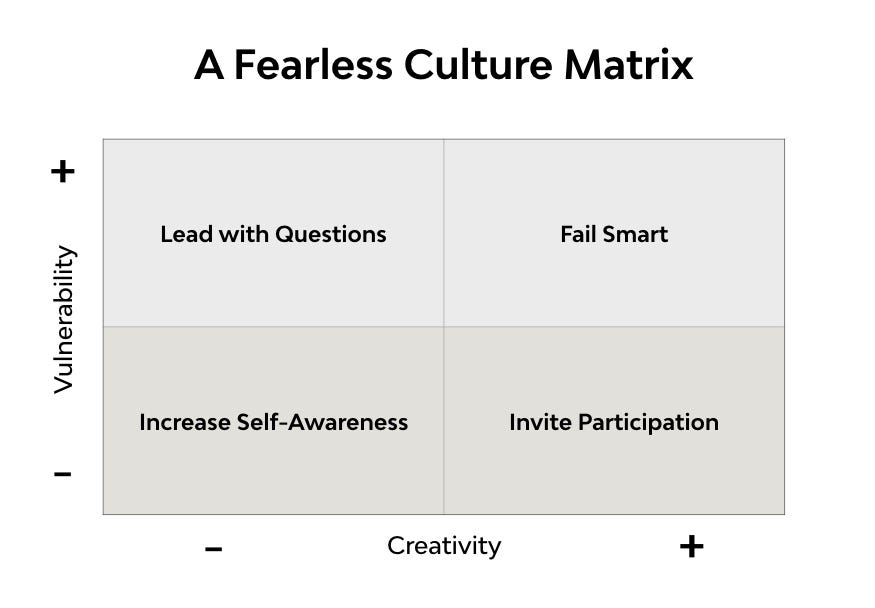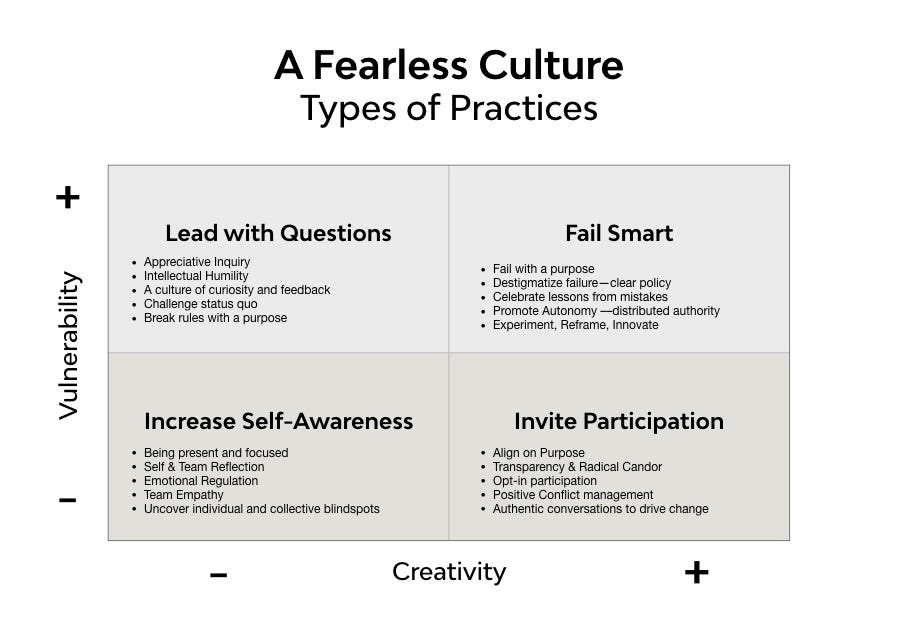The fear of speaking up is pervasive — unfortunately, most people don’t realize it.
Silence is unnoticed, but the costs of fear shouldn’t — they are massive. According to Harvard professor Amy Edmondson, companies waste millions of dollars because most employees stay silent.
Speaking up is vital to drive progress and innovation. If you or your team stay silent, your organization loses invaluable input. People don’t just hold back bad news or dissent, but ideas for improvement and growth.
Holding back is natural. Silence is intuitive when we don’t feel safe. That’s why most of us think twice before sharing an idea or asking a question during a meeting. We don’t want to be laughed at, ridiculed, ignored, or punished — we think speaking up will get us into trouble.
Organizations need creativity and innovation, not silence. Without trouble, there’s no change. A fearless culture encourages participation — everyone shares their ideas and thoughts to move the company forward.
So, how do you get started?
First Steps to Building Psychological Safety
Fortunately, I’ve seen a growing interest among companies — they realize the importance of becoming fearless. But, few know where to get started. Or — the challenge I face more often — organizations want to build psychological safety without really changing.
Overcoming fear involves revisiting leadership styles, organizational culture, and team behavior. Be ready to challenge how you think.
Amy Edmonson, author of The Fearless Organization, describes three steps leaders can take to create psychological safety — the shared belief that a team is safe for interpersonal risk-taking.
- Start with the leader — they have to set the stage to frame the work and emphasize purpose.
- Inviting participation — leaders must practice inquiry, humility, and set up processes.
- Responding productively — appreciate participation and destigmatize failure.
Getting buy-in from senior leaders is vital to building psychological safety across an organization. However, this shouldn’t stop you. Many successful revolutions happen from the inside-out. You can create safe spaces even within a toxic culture.
I’m not a fan of 2×2 matrices — they can be deceiving or oversimplify things. However, I came up with one to organize and help my clients better understand what it takes to build a Fearless Culture.

In my experience, there are two key elements at play: vulnerability and creativity — both feed off each other.
Vulnerability is a challenging concept. We are taught to look confident, assertive, and in control. Being vulnerable is the opposite. We must be humble to acknowledge our humanity, emotions, and flaws. It’s something that everyone must embrace and practice — leaders, teams, and individuals.
Creativity is more than the ability to solve complex problems — it’s an essential metaskill for the 21st Century. Dealing with uncertainty and ambiguity requires adapting to a dynamic reality. Creativity helps us reframe and solve unexpected day-to-day issues.
Each quadrant addresses a different challenge.
- Increase Self-Awareness: We cannot lead others if we can’t lead ourselves first. Knowing oneself is critical to becoming an agent of change. Most of us think we know ourselves well, but only a few really do. It takes courage to confront with our unknown unknowns.
- Lead with Questions: Lead as if you are right but listen as if you are not.Intellectual humility makes you a better leader. In a complex, rapidly changing world, you cannot have all the answers. Asking excellent questions is more important than pretending we know it all.
- Invite Participation: Authentic conversations, not Powerpoints, drive change. People want to actively be part of the conversation, not just feel involved. Participation not only defeats silence — people feel less resistant when they have a saying on how things should work.
- Fail Smart: Failure is not a destination but a necessary stop in the innovation journey. Fearless cultures don’t hide their mistakes. They share them openly — learning and improvement matter more than egos. It also prevents others from repeating the same error.
How Companies Build Fearless Cultures
This matrix has also helped me capture the different practices to build Fearless Cultures — what I’ve learned from researching what companies are doing as well as my own practice.
To keep this post short, I will share some methods and provide links for further reading. It will help you understand the overall approach. Feel free to reach out if you have questions or check out this workshop.

a. Increase Self-Awareness
Embracing vulnerability requires courage — trust starts within yourself.
Self-awareness is much more than understanding yourself — it’s learning to how others see us too. Increased self-awareness takes time and regular practice. The good news? You can start small.
Organizational psychologist Tasha Eurich recommends establishing the habit of a daily check-in — most self-aware people practice it. Ask yourself these three questions at the end of each day:
- What went well today?
- What didn’t go so well today?
- How can I be smarter tomorrow?
Many companies, like Medium, practice a check-in round at the beginning of a meeting to increase team awareness.
By asking “What’s got your attention?” the team realizes the emotions and feelings each person is bringing to a meeting. Understanding where everyone is coming from promotes empathy and reduces useless conflicts.
Here’s a compilation of 15 exercises to develop self-awareness at an individual and team level.
b. Lead with Questions
Leadership need to shift from owning knowledge to promoting a culture of curiosity. Questions encourage ‘quiet people’ to speak up. As Edmondson said, “Questions create a vacuum that serves as a voice opportunity for someone. They create a small safe zone automatically.”
Questions promote transparency. Take this one for example: “If I leave the company, what would you like the new CEO to change?”
This question makes it safe to talk about what the CEO can improve. First, because she/he is sending the message that she/he won’t be there forever. Second, it’s acknowledging that she/he is not addressing all expectations. Lastly, it drives a sense of urgency — it helps uncover issues that are meaningful and critical to the team.
Similarly, Steve Jobs was getting anxious that Pixar employees weren’t speaking up at the end of staff meetings. He realized he had to change the question. “Do you have any feedback?” wasn’t encouraging people to talk.
Jobs overcame silence by asking, “What’s not working at PIXAR? What’s working at Pixar?”
The first question invited people to discuss what needed to be fixed. It came from a place of honesty and vulnerability. The second one balanced the other — it helped people appreciate the positive things.How to Lead with Questions, Not Perfect Answers
“Bureaucracies are built by and for people who busy themselves proving they are necessary, especially when they suspect…blog.liberationist.org
c. Fail Smart
Do you have a mistake policy?
Errors are a necessary path toward innovation. Explicit your company approach to mistakes and risk-tolerance — live it and reward those who experiment.
Ratan Tata, founder and chairman of Tata, created a prize for the Best Failed Idea. He believed failure is a gold mine and wanted to spark innovation and keep his team from avoiding risks.
Don’t fail fast — fail smart. Mistakes are lessons in disguise. Errors are not something to feel guilty about.
Social Media consultancy NixonMcInnes created the Church of Fail — it’s not a new religion but a way of making it okay to err. This monthly ritual celebrates mistakes. Anyone can get on the pulpit to share their own — and what they’ve learned.
Traditional brainstorm processes favor extroverts, people with positional power, those who can think quickly, or like to process ideas by speaking out loud.
Overcoming fear takes time. The 1–2–4-All method is a way to access the inherent power and potential of a diverse group. Firstly, participants brainstorm by themselves, secondly, in duos. Thirdly, in groups of four. In the end, everyone shares their best ideas.
Brainstorming progressively builds creative confidence — one person at-a-time.
Encouraging autonomy and distributing authority help build Psychological Safety —they are essential to develop a culture of experimentation. Listening to people’s ideas is not enough — organizations must give them more space to make decisions too. Don’t protect your team — there’s no growth without failure first.
d. Invite Participation
Change cannot be managed by a small group of executives — it’s a shared responsibility by everyone in the organization. Participation not only drives ownership — it multiplies the number of ideas and perspectives.
Appreciative inquiry is a smart way to drive change through co-creation. It engages all stakeholders in self-determined change — organizations are designed, maintained and transformed by conversations.
Managers do not have all the answers. Increased participation drives engagement and speed. Invite and conquer — let your team choose rather than being forced to support change.
Listen to all the voices. Software developer Atlassian practices conversational turn-taking to ensure even participation — all team members get their turn to speak up. Managers or loud people go last to avoid influencing or silencing others.
Make participation optional. Sounds counterintuitive but it works. People become more committed when they feel in control. Similarly, self-selection — choosing one’s activities and team — increases accountability and performance.
The “Law of Two Feet” is an essential component of the Open Space Technology (OPT) approach. People can leave a meeting when they feel they are wasting their time. It makes it safe to choose one’s priorities wisely.
Participation is recognizing that together we create better solutions. Check out this post to discover other methods to generate conversations that drive change.
Your human talent is your most significant competitive advantage. Imagine all they can do if they weren’t afraid to speak up.
A Fearless Culture encourages people to bring their best selves to work. Overcoming fear requires time — start small and be consistent. Building vulnerability and creativity will advance your organization. Take the first step.
This post was originally published on Medium

